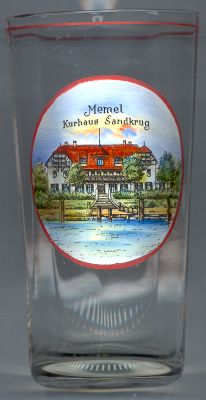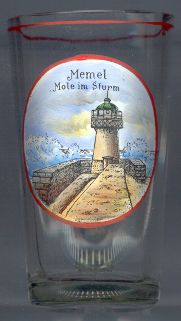

|
| LIETUVA | LITHUANIA |
| Klaipėdos apskritis | Klaipeda county |
Klaipėda is situated at the northern end of the Curonian Lagoon at the narrow strait connecting the lagoon with the Baltic Sea. Klaipėda is Lithuania's only seaport and has major ferry connections to Sweden, Denmark and Germany. Its population is about 191,000 (2003; down from 207,000 in 1992).


The picture on glass no. 1869 [left] shows the
 Kurhaus
Kurhaus
The picture on glass no. 1960 [right] shows the historic
 North
North
The Curonian Spit sand dune peninsula, which is 98 km long and is administered by the municipalities of Klaipėda and Neringa,
was listed as a World Heritage site by UNESCO in 2000 (see list of other World Heritage sites depicted on
glasses of this collection).
The region was inhabited by Baltic tribes already for more than a thousand years when these people
founded a castle at this site at some time during the 13th century. The castle was located between the countries
of the Teutonic Knights and those of the Livonian Brothers of the Sword. Town and castle were conquered by
the Teutonic Order in 1252 and were handed over to the Livonian Brothers.
In 1257 the town was chartered as a town according to the city laws of Lübeck.
At this occasion, the town was named Memele castrum, which translated into German as Memelburg, Memel or Mimmelburg.
A few documents refer to the town as
After World War I the Treaty of Paris (Versailles) the Memel region was separated from the German Empire and in 1920 received an autonomous, German, administration under French supervision. Lithuania occupied the Memel region in 1923 and although Great Britain, France, Italian and Japan guaranteed the special status of the region as autnonomous within the Lithuanian state, the tensions between Germans and Lithuanians continued. In 1938, 88% of the inhabitants of the region voted for a return to Germany. Under pressure from Nazi Germany, Lithuania returned the region to Germany also because it expected support against Poland, which at the time had occupied the Lithuanian capital, Vilnius. After World War II, Memel was incorporated into the Lithuanian Soviet Republic and was officially renamed Klaipėda because the name Klaipėda had been used occasionally during the 19th century and was used regularly by the Lithuanian population since about 1925. When Lithuania became independent from the Soviet Union in 1990, Klaipėda obtained a special status which became the basis for a period of vigorous economic growth.
[http://www.memelland-adm.de/memelstadt.html, http://www.memelland-adm.de/stadtgeschichte.html,
http://www.biblioteka.lt/paveldas/statiniai/S205en.htm;
http://www.lighthouseclothing.com/database/uniquelighthouse.cfm?value=3703]
![[scale]](lineal.jpg)